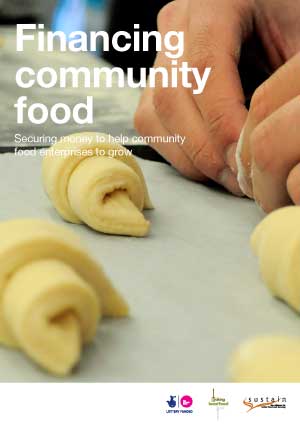
Financing community food: Securing money to help community food enterprises to grow
978-1-903060-54-4 - 28pp - 2013 | 1230Kb

Financing community food: Securing money to help community food enterprises to grow
978-1-903060-54-4 - 28pp - 2013 | 1230Kb
 This report examines the funding needs of community food enterprises and how they can continue to use food to achieve a wide variety of important social and environmental benefits.
This report examines the funding needs of community food enterprises and how they can continue to use food to achieve a wide variety of important social and environmental benefits.
The report was written following a series of community food finance meetings, bringing together organisations that assist community food enterprises, with progressive funders. This process was undertaken as part of the five-year Big Lottery funded Making Local Food Work programme that has – since 2007 – supported a wide range of community-run food enterprises to help communities take control of their food and where it comes from. The community food finance meetings discussed how best to secure funds for community food enterprises in the future, to help them through the all-important start-up phase, and to obtain funds to grow and, thereby, continue work that has more charitable than commercial aims.
We hope to see the community food movement grow and thrive, hence the enterprises need improved prospects for securing the finance they need to succeed. With this report, and work evolving from it, we wish to encourage conversations between enterprises and their communities, the sector organisations that support them, the individuals and organisations that provide funds, and with government, whose policies provides the framework in which we operate.
As with all enterprises and organisations, the need for external funding is ever-present. This might be for start-up finance for a trading enterprise, an investment in equipment, vehicles or enterprise development, or to subsidise the more socially or environmentally focused work that may never be fully financially viable. Most of the community food enterprises we have worked with are structured as co-operatives or community interest companies, or charities structured as companies limited by guarantee. None pay dividends to shareholders, although some may issue shares or loan stock. Very few own assets such as land or buildings against which loans can be secured. Even where income-generating potential is good, income can fluctuate – varying due to, for example, the school calendar and variable local food availability through the seasons.
We therefore set out to ask questions such as where should community food enterprises now go to get the sympathetic and socially-motivated investment they need and deserve? What types of funding are most suited to community food enterprise, such as grants, loans and community finance, and what are the strengths and drawbacks of each? What would it take for sympathetic funds to be made readily available? How much is needed? How should funders present those opportunities? And how should the community food enterprises, in turn, develop and present themselves to make a convincing case for that investment?
Contents
Summary
1. Introduction
2. The enterprise funding landscape
3. Opportunities for change
a) Helping enterprises become “investment ready”
b) Increasing the availability of finance
c) Improving connections between enterprises and funders
4. Making change happen: what next?
5. Sources of useful information
Appendix 1: The Breedon Report
Appendix 2: The Village Core programme
Making Local Food Work: Making Local Food Work aimed to reconnect people and land through local food by increasing access to fresh, healthy, local food with clear, traceable origins.
Sustain
The Green House
244-254 Cambridge Heath Road
London E2 9DA
020 3559 6777
sustain@sustainweb.org
Sustain advocates food and agriculture policies and practices that enhance the health and welfare of people and animals, improve the working and living environment, promote equity and enrich society and culture.
© Sustain 2024
Registered charity (no. 1018643)
Data privacy & cookies